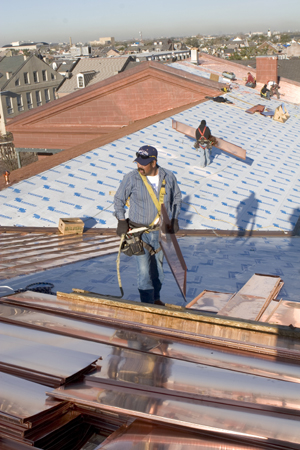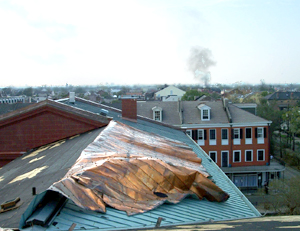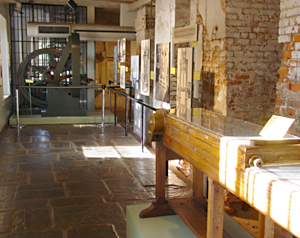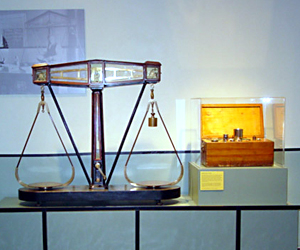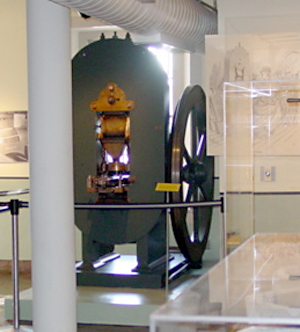Hurricanes' Impact on New Orleans Numismatics
By Leon Worden
September 2006
| O |
Built in Baltimore in 1853, the SS Republic was five days out of New York when a hurricane blew her off course. She'd survived service in both the Confederate and Union armies, but this was too much. Bound for her home port of New Orleans and loaded with silver and gold to aid the reconstruction of the South, she never made it. At 4 p.m. on October 15, 1865, she sank 1,700 feet into the deep. Down with her went a trove of coins with an estimated face value of $400,000.
The "Lost Gold of the Republic" remained true to its name until 2003 when Odyssey Marine Exploration, a deep-ocean shipwreck hunting firm out of Tampa, found it 100 miles off the coast of Georgia.
Through February 2005, Odyssey Marine recovered approximately one-quarter of the coins (51,000) along with 14,000 other artifacts, including 6,000 glass bottles. The coins included a wide array of dates and mint marks: $10 eagles from 1838 to 1865 and $20 double eagles from 1850 to 1865, struck in Philadelphia, San Francisco and New Orleans, with various half dollars and quarter dollars strewn about the sea floor.
|
With a Hooters bar, Ripley's Believe It or Not and a Virgin Megastore for neighbors, Odyssey Marine opened its Shipwreck & Treasure Adventure inside Jax Brewery in New Orleans' French Quarter on Saturday, Aug. 27, 2005.
Opening day ended a few hours early.
Katrina was coming.
She'd hit Florida as a tropical storm on Aug. 25, then gathered strength over the Gulf of Mexico. By Aug. 27 she had reached Category 3 intensity and was building quickly. At 10 o'clock the next morning, New Orleans Mayor Ray Nagin ordered a mandatory evacuation; at 1 p.m. Katrina was a Category 5 hurricane with maximum sustained winds of 175 mph. When she hit New Orleans on Monday, Aug. 29, at 6:10 a.m., she was back down to Category 3 level with 120-mph winds, and by midday, many thought the worst was over.
Then the levees broke.
Eighty percent of metropolitan New Orleans stands below sea level along Lake Pontchartrain. The official death toll stood at 1,836, but 705 people remained categorized as missing nine months later. Katrina was the deadliest hurricane since the Okeechobee (Fla.) Hurricane of 1928 and the costliest in U.S. history, with total damage estimated at $75 billion — nearly double the second-costliest storm, Hurricane Andrew, when adjusted for inflation.
The two dozen or so employees of Odyssey's Shipwreck & Treasure Adventure were rounded up but they had no jobs to go to.
|
The French Quarter is above sea level, so the attraction wasn't destroyed. But it remained shuttered. The city was abandoned.
A publicly traded company, Odyssey Marine reported full-year net losses of $14.9 million for 2005, compared to net income of $5.2 million in 2004. The company attributed to the losses to declines in the number of independent resellers of Odyssey's coins (six in 2005 versus 13 in 2004) and to a lack of new discoveries of the types of high-end coins their customers seek, as well as to the sinking of the shipwreck exhibit.
The exhibit reopened Feb. 15, but even today, tourists are few and far between. For the quarter ending March 31, the company posted a $3.3 million loss on its shipwreck exhibit and said it was still awaiting word on an insurance settlement.
"Attendance is below our original projections and we are currently losing money on a month-to-month basis," company officials said in a May 5 conference call with investors.
But Odyssey Marine hasn't given up hope.
"We will make the appropriate business decision [about keeping the exhibit in New Orleans] after we assemble all the relevant facts and data about the city's ability to rebound, tourists returning to the city, and of course the financial performance of the attraction," officials said.
Odyssey Marine's stock price hit a 52-week low of $1.52 in late June. A month before Katrina, it was trading at $5.64.
No Tourists, No Business
"The French Quarter is virtually empty. No tourists, no business. The deep pockets are hanging on, but the (businesses) that were on the fence are pretty much going under right now," said Dennis Daray who, nearly a year after Katrina, is still living on the second floor of his business — Southern Coins & Precious Metals in the New Orleans suburb of Metairie.
Metairie is on the right side of the 17th Street Canal (the west side). Daray's house was on the wrong side.
|
"The Monday (of) the storm — it was 10 or 11 a.m. — we made reservations that evening to go out and have a glass of wine and a nice dinner and celebrate that we didn't lose the house," Daray said. "And then before dinner, we were watching the news and they said the levee broke. When we started seeing the pictures the next day, we said, ‘Uh-oh, we've got a problem here.'"
Daray returned to New Orleans a month later to discover that he actually had two problems. One was the house. While it didn't have to be torn down, "basically everything that was in that house is gone. The furniture, the sheet rock, electrical, plumbing, fixtures, appliances, everything."
He's rebuilding it, and today Daray is one of few people in the affected area to be growing a lawn. Much of the city remains covered in a foul-smelling muck. Most vegetation is dead.
The second problem was his "other" business. Daray owned The Coin Vault, a shop inside the historic New Orleans Mint where he sold "anywhere from 3-cent silver all they way up to $20 gold pieces" that had been made in that very building during its operational years of 1838 to 1861 and 1879 to 1909. The shop, which he has run since 1995, also offered oil paintings and hard-to-find recordings of famous jazz musicians.
The Mint sits on the highest part of the French Quarter, so it wasn't flooded. But Katrina tore away part of the copper roof.
"We were on the first floor," Daray said. "We were very fortunate. Nothing got ruined. We were able to get back in there after the storm and retrieve virtually everything that was in there."
Looting was a horrendous problem throughout New Orleans — and still is, Daray says — but the Mint itself wasn't looted.
"Of course the Mint is a fort," he said. "It's a great deterrent to crime. The Mint was pretty much buttoned up. There are huge doors that close it, and then we had gates across our area."
Daray operated the store under a vendor license with the state of Louisiana, which has owned the building since 1966.
One of 14 properties in the Louisiana State Museum system, the "Old U.S. Mint" housed the state's collection of old coining equipment, paintings, photographs, works on paper and historical jazz artifacts such as Louis Armstrong's first coronet, Sidney Bechet's soprano saxophone and Kid Ory's trombone — until about a year ago.
"We went in there early and were able to triage what had gotten wet," said Greg Lambousy, director of collections for the museum system. "We evacuated [the material] beginning the first Wednesday after the storm."
Luckily, only about 3 percent of the museum collections sustained water damage. With help from the staff at the LSU Hill Memorial Library, the University of Louisiana Lafayette and State Archives Division of the Louisiana Secretary of State, the artifacts were freeze-dried and stabilized, he said.
Old minting equipment included an 1868 coin press, counting machines and scales. They were carted away to a temporary storage facility near Baton Rouge.
As to whether all of the various collections will be returned to the Mint building when repairs are complete, "It's still to be determined," Lambousy said, "but the (numismatic) exhibit will go back." Plans to enhance the money collection were delayed but not scrapped; just prior to Katrina, the museum took possession of New Orleans type coins it had planned to display in November. Also, the jazz exhibit is to be expanded to encompass all New Orleans music genres, Lambousy said.
"The roof is just about complete," Lambousy said in late June. "They're replastering the exterior; I think they're almost finished with that, too, and repainting the entire exterior. They're getting ready to move to the interior soon."
Repairs are being funded by the Louisiana Office of Risk Management. "To my knowledge we haven't received anything from FEMA as of yet," Lambousy said.
While the building will come back, the fate of the 130 to 140 museum employees who worked at the Mint facility is less clear.
"[The workforce] has been significantly reduced," Lambousy said. "I think we lost about 35 percent of our staff, and we're still losing people. Some people lost their houses and decided to move on, or they were displaced for such a lengthy period of time that they ended up having to find jobs elsewhere."
|
Daray hopes to reopen the shop but "can't even get a rough date as to when they're going to reopen" the building.
"I always wanted a coin shop in the U.S. Mint. I mean, if you're in New Orleans or Denver and you're in the coin business, by golly you want one. What's better than that? It wasn't a real money maker, but it was something you could tell people: ‘I've got a coin shop in the U.S. Mint.' And guess what? I don't think anybody else does!"
Seasoned Pros
Daray's primary business, Southern Coins, is the money maker. It doesn't depend on the tourist trade, as did his Coin Vault.
"We do some local business, but that has really tapered off. Most of our business is with coin shows and other dealers. It helps to have been around since 1977 because you know a lot of people. We've benefited from that."
"Where we are in Metairie, it's almost business as usual," he said. "Everything is basically open. We have traffic jams because you have a lot of people who didn't live here before last August, and now they're out here because their homes got destroyed."
A New Orleans native, Daray couldn't have done a better job preparing his core business, Southern Coins, for the worst.
"We have a two-story, 5,000-square-foot building," Daray said. "I bought this building probably two years ago. I'm not much into retail [trade]. I don't want people just walking in. We've got high-value items. We wanted to be able to buzz people in. We wanted security. I built a 12x20-foot walk-in vault with a 6,000-pound door.
"We're seasoned pros when it comes to these storms," he said. "When you're from New Orleans and you know a storm's coming ... there's a drill you go through. You get all your paperwork off the floor, you raise your coins up off the floor, you throw everything in a vault and you run. That's what we did."
Katrina's Big Sister
At least one seasoned pro left Louisiana just in time to run into Katrina's big sister, Hurricane Rita.
Technically stronger than Katrina in terms of atmospheric pressure, Rita hit the Texas-Louisiana border as a Category 3 hurricane on Sept. 24 and swept through southeast Texas where Paul Montgomery was working as numismatic consultant to Mike Fuljenz's company, Universal Coin & Bullion in Beaumont, Texas.
Montgomery had been president of Bowers and Merena Galleries when it launched a marketing campaign in 2003 that led to the reappearance of the "fifth" 1913 Liberty Head nickel (as chronicled in the book, "Million Dollar Nickels" by Montgomery et al., Zyrus Press, 2005). At the time, Bowers and Merena was located in Mandeville, on the other side of Lake Pontchartrain from New Orleans.
"I left Bowers and Merena in 2004 when the company was sold to Spectrum Numismatics," Montgomery said. "It moved to California and I did not move with it."
Instead, Montgomery went home to Texas. He had grown up in the Houston area.
When Rita hit a month after Katrina, "it was a mess," Montgomery said. "We actually had people who evacuated [New Orleans] and came to Beaumont, left and went back to New Orleans and to Mandeville, literally two days before we had to evacuate the city for Rita."
"We have people who are still recovering," he said in June. "There are still a lot of blue tarps on roofs around Beaumont. We had significant damage to this city."
Significant enough for Montgomery and the crew at Universal to move their base of operations to the conference room of a Holiday Inn Express hotel in the small town of Sealy, west of Houston.
"We had only a skeleton staff because our group had scattered all over the country," Montgomery wrote in a company newsletter. "Because of the determination of the management and those staffers near enough and able to get to the command center, we only suspended operations for about ten days."
The company kept its coin and bullion inventory in a vault, and because there was no power in Beaumont, the alarm system didn't work.
"We hired Bob Brueggeman of Positive Protection in [Newport Beach], California," Montgomery said. "He handles security for coin shows. He hired a couple of his guys and they parked a motor home right in the middle of our parking lot and did 24/7 guard duty on our vault."
"Really it was more of a struggle for us to get our people back into their homes, more than it was for our business," he said. "Our people are our business" — and some of them lost their homes.
Checking In
People checking on people in the affected areas in the aftermath of Katrina and Rita was the order of business in the numismatic community as it no doubt was in other tight-knit communities.
Online forums were one way for people to keep in touch. Readers of The E-Sylum, the e-mail newsletter edited by Wayne Homren on behalf of the Numismatic Bibliomania Society (coinbooks.org), learned of efforts not only to help people but also to save important collections.
For instance, under the heading, "New Orleans Numismatic Library Saved," Florida book dealer Fred Lake reported that the widow of a prominent paper money dealer and bibliophile "watched the reports of the developing storm and decided to do a rush job of packing over 1,000 pounds of books so that they would not be subjected to the ravages of the flood she knew would be coming." She was less lucky with her home.
E-Sylum contributor Dick Johnson — the original editor of Coin World in 1960 — posed the question: "How many millions of coins were abandoned in New Orleans as the city was evacuated? Did collectors have to abandon their numismatic collections? Were New Orleans coin dealers able to remove their inventory in time? How about the coins that were left in stores, cash registers and bank vaults? ... The entire city may become a tomb for collectible treasures for the future."
It sounds like it could be a job for Odyssey Marine Exploration. Will the "Treasure of New Orleans," like the "Lost Gold of the Republic," remain buried for 140 years? And if so, will FEMA have come to the rescue by then? Dennis Daray wants to know.
"New Orleans would have been up and running in two weeks without that levee break," Daray said. "There are complete neighborhoods that are nonfunctional. There are no businesses. Some neighborhoods don't even have electricity to this day. Our utility company, weeks after the storm, decided they were going to go Chapter 11."
"I think people need to know this: Help! Please! We really do need the money. We won't pilfer it, I promise."
©2006, MILLER MAGAZINES INC./LEON WORDEN. RIGHTS RESERVED.


